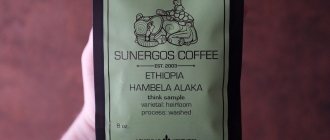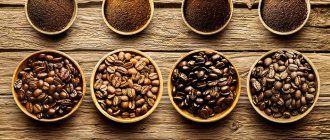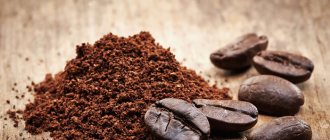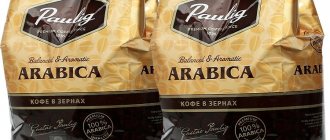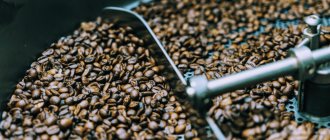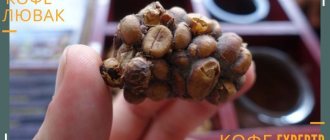Dark roast coffee
This roast is also called “espresso.” Dark roast coffee is intended for a geyser coffee maker, coffee machine or Turk. When brewed using these methods, the coffee is exposed to a quick and intense effect, and the ratio of coffee to water is approximately 1 to 2.
Dark roast coffee has less acidity, it is denser, with a high degree of caramelization of the grain. Therefore, by brewing it, for example, in a Turk, you will get a taste in a cup that is closest to the “classic” one. This will be a rich coffee with a dense body and a characteristic bitter chocolate aftertaste.
Depending on the type of coffee, you will also be able to taste subtle descriptors: dried fruits, berries, spices or other flavors indicated in the description of a particular variety.
Medium roast
Or American, urban, brown. It has a light brown hue (milk chocolate) and a dry surface. Has a richer aroma. The taste is mixed, bittersweet notes predominate, but there is some sourness.
Medium-dark
It is also called: Viennese, full city or corduroy. At this degree of roasting, beneficial essential oils are already released, which is why the surface of the grain is more shiny and oily. Bittersweet notes predominate, the taste is rich and velvety.
Light roast coffee
This roasting is also called “filter roasting”. Light roast is suitable for brewing in a funnel (pour over), French press or just in a cup. The coffee-water ratio in this case is 1 to 14, and the effect on coffee during preparation is more delicate and prolonged.
Light roasted coffee retains more acids, and the degree of caramelization of the grain is weaker, which is why the taste reveals itself brighter and the body of the drink will be less dense. Therefore, when brewing using alternative methods, you will get distinct fruit and berry flavors and a lighter, but at the same time quite rich body.
Among our light roast varieties there are both more acidic and sweeter, with virtually no sourness and a rich range of shades of nuts, spices and chocolate.
Classification of degrees of roasting
When roasted, coffee beans change color. First from green to yellow, then to brown, and then they can even reach black. At the same time, in the coffee industry there is no universal system for designating degrees of roasting, one classification that everyone would consider correct and operate on it. This leads to confusion among roasters and consumers alike, as what one might call a “light roast” another might consider an “American” roast. Below we'll talk about the two classifications to clarify the terminology, and then we'll talk about which degree of roast is best and what to choose.
The first classification is “SIMPLE”. In our coffee catalog we use it, since it is the most “popular” and understandable. According to it, all coffee can be divided into three degrees of roasting:
- light (light brown color)
- medium (brown)
- dark (from dark brown to black)
The second classification is “PROFESSIONAL”. It was introduced by world-famous roaster Scott Rao. It is more accurate, but not clear to ordinary consumers, so we correlated it with the “simple” classification to make it clearer. So, he identified the following degrees of roasting:
Cinnamon (light)- American (light)
- Urban (medium)
- Full city (medium)
- Viennese (dark)
- French (dark)
- Italian (dark)
Deep roast
Colors the grains a deep, dark brown color. They lose a fifth of their weight and a significant portion of their water. A large amount of aromatic oils are released, and strong caramelization of sugar in the grain occurs. Heavily roasted grains produce a finished drink of high density and strength. This is the traditional processing method for Guatemalan, Cuban and some Brazilian varieties.
First degree deep roast
It is also called French or Turkish.
Continues after the second cracking, when the clicks and crackling have almost stopped. Cracks continue to form on the surface of the beans, smoke appears, the aroma of roasted coffee intensifies, and burnt notes appear in it.
The taste of the finished drink is bitter, with caramel and sweet notes. Coffee is distinguished by its high density and strength.
Second degree deep roast
It is also called continental, European or New Orleans.
The grain becomes even darker, acquiring the color of dark chocolate. There are many wide cracks on its surface. There is clearly visible smoke. The most important thing at this stage is not to overcook the grains, otherwise they will quickly start to burn.
The finished drink is thick, dense, strong, with bitter caramel and smoky notes; light tones of burnt sugar may be felt if the sugar content of the variety was high.
Why and how are coffee beans roasted?
Roasting is a heat treatment during which a complex chemical reaction called pyrolysis occurs. As a result of exposure to high temperatures, starch is converted into sugar, fatty acids are oxidized, and essential oils come to the surface of the coffee bean, giving it a special aroma and taste.
To roast coffee correctly, you need to be a real professional, because if you over- or under-roast it a little, you can ruin everything. Moreover, the rate of oil melting is unique for each variety and harvest, so there is no universal formula for calculating the optimal time.
To indicate the stages of frying, experts use the concept of “popping” (clicking or cracking). The first pop occurs at the moment when oil begins to be released from the beans, and after subsequent ones, the coffee turns out to be completely roasted and it will no longer be possible to get more oil from it. Also, when roasting coffee beans, experts pay attention to their shade, which darkens over time.
ROASTING COFFEE AT HOME
But this, I’m sure will be of interest to many. After all, coffee roasting can be used at home. And you don't even need to purchase special equipment. You can perfectly use such kitchen utensils as:
- cast iron frying pan with a thick bottom;
- regular oven.
Then you should know that the frying pan should only be used for roasting coffee beans, because they absorb any foreign odors well and quickly. At the preparatory stage, raw coffee beans are washed and then dried well. Only then the coffee is poured into the frying pan in a thick layer.
It is desirable that the heating temperature of the product should be at least 200 degrees. The beans must be constantly stirred to achieve the perfect all-round roast. During the process, you will be able to hear clicks, as well as observe the color changes of the product yourself - the lighter it is, the softer the taste will be.
Lovers of strong espresso coffee should wait until the beans darken to a darker brown color. This method of roasting coffee beans will give the drink a characteristic bitterness and a pronounced, intense taste.
Coffee is also roasted in the oven. This method of roasting at home is even a little easier, because in the oven you have the opportunity to set a stable temperature and calmly roast the coffee beans to the degree you need.
After roasting the coffee using the method you choose, the beans should cool in an airtight container. For the first 8-10 hours, leave the lid slightly open. This will remove all excess gases from the coffee beans. After about a day, you can pour the beans into an airtight container for storage, at which time you can grind the beans and brew your favorite freshly ground, tasty and aromatic coffee.
CHOOSE GOOD COFFEE RIGHT
Choosing the right good coffee can take time and you need to have an idea of the labeling on the packages, the appearance of the coffee beans and other points. When visiting various Internet portals or stores with a large assortment of coffee, it is easy to get confused in the symbols on the packages, the decoding of which is not known to everyone. You can use the help of a specialist or independently familiarize yourself with information about the preparation of coffee raw materials - these are varieties, roasting, and grinding of coffee.
Before the cup reaches us, the coffee goes through a preparatory stage. Before grinding, coffee beans must be properly roasted. Due to different heat treatment methods, a tandem of different flavors and aromas has become available to us, and it is they that affect the taste of coffee. Next, you select the appropriate coffee to suit your taste.
COFFEE ROASTING AND WHAT TYPES OF ROASTING ARE THERE
After complete heat treatment of coffee beans, their color and, in some cases, size change. There is no generally accepted classification of the degree of roasting of coffee raw materials. Therefore, any country can use its own gradient values indicating the types of coffee roasting used. This is interesting information, we will look at it in this section.
Perhaps the most common designation method used is a scale, numbered from 1 to 5, which can be seen on any packaging of natural coffee. Sometimes, when indicating the types of coffee roasting, the following names are used:
- Viennese roast;
- French;
- Italian;
- Scandinavian;
- American;
- cinnamon;
- urban.
Before heat treatment, the skin of the coffee beans has a smooth texture and a dull olive tint. At the end of roasting, the color changes dramatically; from it you can visually determine the degree of roasting of the coffee bean and, therefore, what taste will prevail in the finished drink.
Viennese roasting of coffee - with it, the beans also become bright brown with a surface covered with an oil film. During the roasting process, smoke comes from the coffee beans and they “shoot.” The finished drink has light acidity and a slightly sweet taste. Remnants of the aroma are still perceptible, but the bitter notes are already present. Quite often, beans that have undergone Viennese roasting are used to make espresso coffee.
French roasting of coffee is perhaps the most common and popular method of preparing coffee. French roasting of coffee gives the beans a peculiar shine, and the drink becomes a rich brown color. Frying is carried out upon completion of the “second crack” - click. Freshly brewed coffee has the rich flavor of well-processed beans and a thick consistency.
Italian coffee roasting involves the highest degree of temperature exposure on the beans, as a result of which the beans become almost black in color. During the process of intense roasting of coffee, the most valuable oil compositions and the unique aroma of the drink are lost. Which, however, does not detract from its advantages when preparing various coffee drinks.
When the Scandinavian roasting method , the beans swell and take on a light brown color. The finished drink has a strong and at the same time light coffee aroma and a pleasant taste.
American coffee roasting – if we are talking about types of coffee roasting, then this is the fastest way. The heat treatment of coffee beans is considered complete after the “first crack” - (a soft click that is characteristic after the evaporation of gases). During the roasting process, the grain becomes visually larger and acquires a deep brown color, the stage of sugar decomposition passes into crystallization, and is characterized by quite strong acidity.
Cinnamon or, as it is also called “light” roasting , is a thermal process in which coffee beans are processed until “one first click”. Roasted coffee beans become light brown in color with a matte tint, but their structure becomes dry and does not have a glossy shine. The finished freshly brewed drink contains a refined taste of coffee with a tart tint and a slightly noticeable, pleasant sourness.
Urban “medium” roasting of coffee involves heat treating the beans until they acquire a rich brown color. This type of roasting releases oils onto the surface that add a glossy appearance to the roasted beans. With medium roast, most of the natural characteristics of the drink are well preserved - an expressive aroma, “caramel” sweetness and a long, caressingly pleasant aftertaste.
Why is roasting necessary?
Unroasted grains have a barely noticeable odor. Their taste is weak. Therefore, they are subjected to heat treatment. Roasting green coffee provokes a kind of fermentation, which releases essential oils. In addition, a number of other processes occur that provoke an increase in the concentration of some components and the release of others.
High temperatures contribute to the release of about four hundred substances. Their mixture is called “coffeeol”. This is what gives the drink its rich aroma. In addition, roasting coffee beans helps to destroy fiber, tannins and lower glucose concentrations.
It is also worth noting that the amount of caffeine depends on the degree of exposure to temperature. Black coffee contains much less alkaloid than coffee made from raw coffee.
Industrial roasting
Considering how much coffee is sold in stores every day, it is difficult to imagine that roasting of beans is still done only by hand. Coffee production factories use special roasters, which are a movable drum with a heating element in which the coffee reaches the desired condition. Modern devices contain special devices for monitoring the state of roasting. However, they cannot completely replace a good master. Therefore, the degree of readiness is determined by a sample, which is assessed by an experienced barista.
Good coffee requires three things, quality beans, proper roasting and proper preparation. All this is not so easy to master, but with the proper skill, even an amateur can prepare a tasty drink from raw grains.
